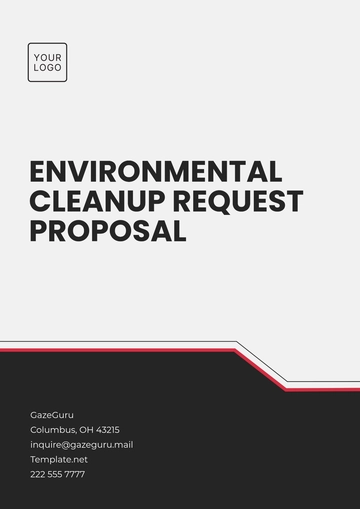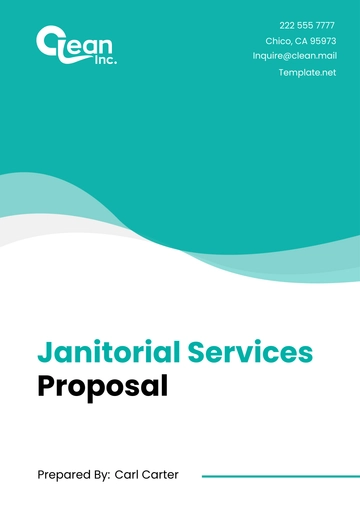Free Solar Energy Proposal

I. Executive Summary
As the global demand for renewable energy continues to rise, [Your Company Name] seeks to position itself at the forefront of this energy revolution by providing a comprehensive, scalable, and sustainable solar energy solution. This proposal outlines the design, engineering, financing, and installation of solar photovoltaic (PV) systems tailored to meet the growing energy needs of businesses, government institutions, and individuals. By investing in solar energy, clients can achieve long-term energy savings, minimize their carbon footprint, and take part in the global transition to cleaner energy sources.
The impetus for this proposal stems from the increasing urgency of climate change and the corresponding need for more sustainable energy sources. With the growing awareness of the environmental impacts of fossil fuels and the fluctuating costs of traditional energy sources, it is imperative that businesses and individuals alike transition to renewable options. Our proposal aims to provide our clients with a solution that can generate reliable power, ensuring that their energy needs are met both today and in the future.
In addition to providing sustainable energy, solar installations can enhance the energy resilience of facilities, making them less vulnerable to grid outages and price fluctuations associated with conventional energy. Through this initiative, [Your Company Name] hopes to contribute to the goal of reducing global carbon emissions by [50%] by the year [2050], in alignment with global renewable energy targets. By harnessing the power of the sun, we can ensure a cleaner, more sustainable future.
II. Project Overview
A. Purpose
The purpose of this proposal is to present a strategic and financial plan to install solar energy systems in properties owned by [Your Client Name]. This initiative will enable [Your Client Name] to significantly reduce their reliance on conventional power sources, lower utility costs, and contribute positively to environmental sustainability. By integrating renewable energy sources, [Your Client Name] can not only save on operational expenses but also strengthen its position as a socially responsible entity in the eyes of stakeholders, customers, and the community at large.
This proposal not only outlines the installation of solar panels but also emphasizes the long-term operational advantages associated with solar energy systems. With predictable energy costs and potential revenue generation through Renewable Energy Certificates (RECs), the solar system offers financial stability and peace of mind.
B. Scope of the Project
This proposal covers:
The assessment of solar energy potential on various facilities.
The design and installation of solar energy systems.
Financial planning for the project.
Maintenance and monitoring of the installed systems.
Expected financial and environmental benefits over the lifecycle of the system.
The project scope extends beyond mere installation; it encompasses thorough feasibility studies, financial modeling, and ongoing support to ensure that the system operates at optimal efficiency. This comprehensive approach allows [Your Company Name] to tailor solutions to meet the specific needs and goals of [Your Client Name], fostering a long-term partnership built on trust and mutual benefit.
C. Project Location
The primary location for the installation of solar energy systems is [Your Client Address]. The area provides optimal solar radiation for most of the year, ensuring high energy production efficiency. The site covers an area of approximately [10,000] square meters, which will allow the installation of PV panels with a capacity to generate up to [1 MW] of power annually.
The geographical location, coupled with favorable weather patterns, positions [Your Client Name] to benefit from a high number of sunlight hours throughout the year. This not only maximizes the energy output but also enhances the overall return on investment for the solar installation.
III. Solar Energy Systems
A. Photovoltaic (PV) Panels
Photovoltaic panels are the core component of the solar energy system. They convert sunlight directly into electricity using semiconductor technology. The PV panels to be installed will be:
Monocrystalline Solar Panels: Monocrystalline panels are known for their high efficiency and durability. These panels offer better energy conversion rates, making them ideal for limited space and maximizing energy output. The sleek design and uniform appearance of monocrystalline panels make them a preferred choice for modern installations.
Polycrystalline Solar Panels (Optional): These panels provide a cost-effective option, with slightly lower efficiency compared to monocrystalline panels. They may be utilized in areas where space constraints are not a significant factor. Their manufacturing process is less energy-intensive, making them a more environmentally friendly option in terms of production.
Table 1: Comparison of Solar Panel Types
Panel Type | Efficiency | Lifespan (Years) | Price per Watt ($) | Space Required (m²/kW) |
|---|---|---|---|---|
Monocrystalline Panels | [20%] | [25] | [$0.30] | [5] |
Polycrystalline Panels | [15%] | [20] | [$0.25] | [7] |
B. Inverters
Inverters are critical in converting the direct current (DC) generated by solar panels into alternating current (AC), which is the form of electricity that can be used by standard electrical appliances.
Types of Inverters to be used:
String Inverters: These inverters are connected to several solar panels, typically arranged in a string. They are cost-effective for large installations but can be less efficient if shading or obstructions occur on some panels. String inverters are particularly well-suited for applications where the panels receive uniform sunlight.
Microinverters: Microinverters are installed on each solar panel individually, ensuring optimal energy production even if one panel is shaded. They are more expensive than string inverters but provide better performance under partial shading conditions. Microinverters allow for enhanced monitoring capabilities, enabling real-time tracking of each panel's performance.
C. Mounting Systems
The mounting system is the structural foundation for the PV panels. Depending on the project site, different mounting configurations will be used:
Roof-Mounted Systems: Best suited for sites with limited ground space. Roof-mounted systems will use either slanted or flat roof configurations to ensure maximum sunlight exposure. These systems are designed to withstand high winds and adverse weather conditions, ensuring long-term durability.
Ground-Mounted Systems: Ideal for large, open areas. These systems will allow flexibility in panel orientation and tilt to capture the maximum amount of sunlight. Ground mounts can be adjusted to optimize performance and may include tracking systems that follow the sun's path throughout the day.
D. Energy Storage (Optional)
Energy storage systems, such as lithium-ion batteries, can be included to store excess solar energy for use during cloudy days or at night. Although optional, energy storage enhances the reliability and independence of the solar energy system.
Benefits of Including Energy Storage:
Energy Independence: With storage, the client can continue using solar-generated electricity even when the sun isn't shining or during grid outages. This independence from the grid can significantly reduce vulnerability to energy price fluctuations.
Peak Shaving: Batteries can be used to avoid peak electricity charges by using stored solar power during high-demand periods. This capability can lead to additional savings and optimize energy usage throughout the day.
IV. Financial Analysis
A. Cost Breakdown
The following table provides a breakdown of the installation cost for the solar energy system. It encompasses all components necessary for the successful execution of the project, ensuring transparency and clarity regarding the financial investment.
Table 2: Cost Breakdown of the Solar Energy System
Item | Estimated Cost ($) | Description |
|---|---|---|
Photovoltaic Panels | [$300,000] | Includes [1,000] monocrystalline panels, known for their efficiency and longevity. |
Inverters (Microinverters) | [$50,000] | [1,000] microinverters ensuring optimal performance across all panels. |
Mounting System | [$75,000] | Roof-mounted system designed for durability and maximum sunlight capture. |
Installation Labor | [$150,000] | Includes skilled labor for electrical wiring and installation of all components. |
Permitting and Inspections | [$10,000] | Includes fees for local permits and necessary inspections. |
Energy Storage (Optional) | [$120,000] | Lithium-ion batteries for [500 kWh] of storage capacity, providing backup energy. |
Monitoring System | [$10,000] | Monitoring software and hardware for real-time energy production tracking. |
Miscellaneous Costs | [$5,000] | Transportation, safety equipment, and other unforeseen expenses. |
Total Estimated Cost | [$720,000] | Comprehensive total for the entire solar energy system installation. |
B. Payback Period
The payback period is the time required to recover the initial investment in the solar energy system through savings on energy bills. Based on current electricity prices and the energy production capacity of the system, the expected payback period is approximately [7] years.
This timeline reflects the anticipated decrease in utility costs as energy is produced from the solar panels rather than purchased from the grid. It is important to note that as electricity prices continue to rise, the payback period may shorten, leading to increased savings for [Your Client Name].
Table 3: Annual Savings and Payback Calculation
Year | Energy Savings ($) | Cumulative Savings ($) | Remarks |
|---|---|---|---|
Year 1 | [$100,000] | [$100,000] | Based on energy production of [1 MW], significantly reducing monthly energy bills. |
Year 2 | [$105,000] | [$205,000] | Continued savings as energy costs rise. |
Year 3 | [$110,000] | [$315,000] | Increasing savings with potential incentives. |
Year 4 | [$115,000] | [$430,000] | Cumulative savings accelerating with time. |
Year 5 | [$120,000] | [$550,000] | Substantial savings, nearing payback period. |
Year 6 | [$125,000] | [$675,000] | Major cost savings realized as investment recouped. |
Year 7 | [$130,000] | [$805,000] | Investment fully recouped, ongoing savings begin. |
C. Financial Incentives
Various federal, state, and local incentives can significantly reduce the upfront cost of solar installations. This includes:
Federal Investment Tax Credit (ITC): The ITC allows businesses to deduct [26%] of the installation costs from federal taxes. This credit incentivizes the adoption of solar technologies by providing substantial tax savings.
State Incentives: Various states offer additional rebates or tax credits for solar installations. These can vary significantly, so it is essential to explore opportunities within [Your State].
Renewable Energy Certificates (RECs): By generating renewable energy, [Your Client Name] can earn RECs, which can be sold in the market, providing an additional revenue stream.
By taking advantage of these incentives, [Your Client Name] can further reduce the overall costs associated with the project, effectively shortening the payback period and enhancing the financial viability of the investment.
V. Environmental Impact
A. Carbon Emissions Reduction
The adoption of solar energy will significantly reduce carbon emissions associated with energy production. Based on the projected energy generation from the solar system, [Your Client Name] can expect to eliminate approximately [600,000 kg] of carbon dioxide (CO2) emissions annually. This reduction aligns with global efforts to combat climate change and underscores the commitment of [Your Client Name] to corporate social responsibility.
The reduction of carbon emissions not only benefits the environment but also enhances [Your Client Name]'s brand reputation among customers and stakeholders who increasingly prioritize sustainability. Companies that actively engage in carbon reduction initiatives are often viewed more favorably, leading to improved customer loyalty and potential new business opportunities.
B. Conservation of Resources
By utilizing solar energy, [Your Client Name] will contribute to the conservation of natural resources. Solar energy is renewable, meaning it does not deplete finite resources such as fossil fuels. This shift contributes to a more sustainable energy future by reducing the strain on natural resources and minimizing habitat destruction associated with resource extraction.
C. Public Health Benefits
Transitioning to solar energy also has public health benefits. By reducing reliance on fossil fuels, [Your Client Name] will help decrease air pollution, leading to better air quality and improved public health outcomes. Studies show that reduced air pollution can significantly lower the rates of respiratory and cardiovascular diseases, ultimately benefiting the local community.
VI. Implementation Plan
A. Project Timeline
A well-defined project timeline is crucial for the successful implementation of the solar energy system. The following timeline outlines the key phases of the project:
Table 4: Project Timeline
Phase | Timeline | Description |
|---|---|---|
Feasibility Study | [Month 1 - Month 2] | A comprehensive assessment of site suitability, solar potential, and initial financial analysis. This phase will involve data collection and analysis to ensure the project meets expected outputs. |
Design and Engineering | [Month 3 - Month 4] | Detailed system design, including layout, component specifications, and electrical schematics. Collaboration with engineers and architects to ensure compliance with local regulations. |
Permitting and Approvals | [Month 5] | Obtaining all necessary permits and approvals from local authorities. This phase may include environmental assessments and impact studies. |
Procurement | [Month 6] | Sourcing high-quality materials and components. This includes establishing relationships with suppliers to secure favorable pricing and delivery schedules. |
Installation | [Month 7 - Month 9] | Physical installation of solar panels, inverters, and other necessary equipment. Coordination among installation crews, electricians, and project managers to ensure timely execution. |
Testing and Commissioning | [Month 10] | Conducting thorough system tests and inspections to ensure optimal performance. This phase will include final checks and adjustments before the system goes live. |
Operational Start | [Month 11] | The solar system officially begins generating electricity for [Your Client Name]. Monitoring systems will be activated to track performance metrics. |
Ongoing Maintenance | [Month 12 - Onwards] | Scheduled inspections and maintenance to ensure the solar energy system operates efficiently and effectively over its lifespan. |
B. Roles and Responsibilities
The success of the project hinges on effective collaboration between [Your Company Name], subcontractors, and [Your Client Name]. Below is a summary of the key roles and responsibilities:
Role | Responsibilities |
|---|---|
Project Manager | Oversees project execution, coordinates teams, and manages timelines. The Project Manager will ensure that all stakeholders are kept informed throughout the process and that the project stays within budget. |
Design Engineer | Develops system designs and ensures compliance with local regulations. The Design Engineer will be responsible for integrating client specifications into the design and addressing any engineering challenges that may arise. |
Procurement Officer | Sources materials and manages supplier relationships. The Procurement Officer will ensure that all materials are of high quality and delivered on time to avoid delays in the project timeline. |
Installation Crew | Responsible for installing solar panels and systems, performing electrical work, and ensuring that all installations are completed safely and efficiently. |
Maintenance Technician | Conducts routine inspections and maintenance tasks. The Maintenance Technician will be crucial for ensuring the system remains operational and efficient throughout its lifespan. |
Financial Analyst | Monitors financial performance and savings associated with the solar energy system. The Financial Analyst will provide ongoing reports to assess the system's impact on overall financial health. |
C. Risk Management
Identifying and managing risks associated with the solar energy project is critical to its success. The following are potential risks and mitigation strategies:
Table 5: Risk Management Strategies
Risk | Description | Mitigation Strategy |
|---|---|---|
Regulatory Changes | Changes in local or federal regulations could impact the project. | Stay informed of policy changes and adjust plans as necessary. Regular communication with local authorities will help anticipate changes. |
Supply Chain Disruptions | Delays in material delivery could extend the timeline. | Maintain relationships with multiple suppliers and monitor inventories closely. Establish contingency plans to source alternative materials quickly. |
Technological Challenges | Equipment failure could affect performance. | Use high-quality components and conduct thorough testing pre-commissioning. Engage in warranties and service agreements with manufacturers for long-term support. |
Environmental Factors | Weather conditions may hinder installation. | Plan installation during favorable weather conditions and have contingencies in place, such as flexible scheduling to accommodate delays due to inclement weather. |
VII. Conclusion
The implementation of a solar energy system presents a transformative opportunity for [Your Client Name]. By embracing solar technology, [Your Client Name] will benefit from significant energy savings, reduced operational costs, and an enhanced reputation as a leader in sustainable practices. This transition to renewable energy is not only financially prudent but also essential for ensuring environmental stewardship and corporate social responsibility.
This proposal outlines a comprehensive approach to solar energy adoption, covering every facet from project planning to execution and maintenance. [Your Company Name] is committed to ensuring the successful delivery of this project, providing expertise, support, and innovation throughout the entire process. We believe that investing in solar energy is not just an opportunity for financial savings, but also a crucial step toward a sustainable future for our communities and the planet.
By partnering with [Your Company Name], [Your Client Name] will be taking a bold step into the future of energy. We look forward to the opportunity to collaborate on this project, making a lasting positive impact on both your energy needs and environmental footprint. Together, we can pave the way for a greener tomorrow.
VIII. Appendices
A. Technical Specifications
The following are the detailed technical specifications for the proposed solar energy system:
Solar Panel Specifications:
Model: [Model Name]
Efficiency: [20%]
Dimensions: [1.65m x 1m]
Weight: [20 kg]
Power Output: [350 W]
Inverter Specifications:
Model: [Inverter Model]
Rated Power: [1,000 W]
Efficiency: [95%]
Dimensions: [0.7m x 0.5m x 0.3m]
Weight: [30 kg]
Battery Storage Specifications (if applicable):
Model: [Battery Model]
Capacity: [500 kWh]
Type: Lithium-Ion
Lifespan: [10 years]
Depth of Discharge: [80%]
B. Energy Production Estimates
Below is a projection of the expected energy production based on the location and solar panel capacity:
Table 6: Energy Production Estimates
Month | Expected Energy Production (kWh) |
|---|---|
January | [90,000] |
February | [80,000] |
March | [100,000] |
April | [120,000] |
May | [130,000] |
June | [140,000] |
July | [150,000] |
August | [140,000] |
September | [130,000] |
October | [110,000] |
November | [95,000] |
December | [85,000] |
C. References
U.S. Department of Energy. (2050). "Solar Energy Technologies Office."
National Renewable Energy Laboratory. (2050). "Renewable Energy Data Book."
International Renewable Energy Agency. (2050). "Renewable Energy Capacity Statistics."
- 100% Customizable, free editor
- Access 1 Million+ Templates, photo’s & graphics
- Download or share as a template
- Click and replace photos, graphics, text, backgrounds
- Resize, crop, AI write & more
- Access advanced editor
Win clients with the Solar Energy Proposal Template from Template.net. This editable and customizable template helps you present your solar solutions, pricing, and benefits in a professional format. Use our Ai Editor Tool to personalize your proposal, effectively communicating your value to prospective customers.
You may also like
- Business Proposal
- Research Proposal
- Proposal Request
- Project Proposal
- Grant Proposal
- Photography Proposal
- Job Proposal
- Budget Proposal
- Marketing Proposal
- Branding Proposal
- Advertising Proposal
- Sales Proposal
- Startup Proposal
- Event Proposal
- Creative Proposal
- Restaurant Proposal
- Blank Proposal
- One Page Proposal
- Proposal Report
- IT Proposal
- Non Profit Proposal
- Training Proposal
- Construction Proposal
- School Proposal
- Cleaning Proposal
- Contract Proposal
- HR Proposal
- Travel Agency Proposal
- Small Business Proposal
- Investment Proposal
- Bid Proposal
- Retail Business Proposal
- Sponsorship Proposal
- Academic Proposal
- Partnership Proposal
- Work Proposal
- Agency Proposal
- University Proposal
- Accounting Proposal
- Real Estate Proposal
- Hotel Proposal
- Product Proposal
- Advertising Agency Proposal
- Development Proposal
- Loan Proposal
- Website Proposal
- Nursing Home Proposal
- Financial Proposal
- Salon Proposal
- Freelancer Proposal
- Funding Proposal
- Work from Home Proposal
- Company Proposal
- Consulting Proposal
- Educational Proposal
- Construction Bid Proposal
- Interior Design Proposal
- New Product Proposal
- Sports Proposal
- Corporate Proposal
- Food Proposal
- Property Proposal
- Maintenance Proposal
- Purchase Proposal
- Rental Proposal
- Recruitment Proposal
- Social Media Proposal
- Travel Proposal
- Trip Proposal
- Software Proposal
- Conference Proposal
- Graphic Design Proposal
- Law Firm Proposal
- Medical Proposal
- Music Proposal
- Pricing Proposal
- SEO Proposal
- Strategy Proposal
- Technical Proposal
- Coaching Proposal
- Ecommerce Proposal
- Fundraising Proposal
- Landscaping Proposal
- Charity Proposal
- Contractor Proposal
- Exhibition Proposal
- Art Proposal
- Mobile Proposal
- Equipment Proposal
- Student Proposal
- Engineering Proposal
- Business Proposal















